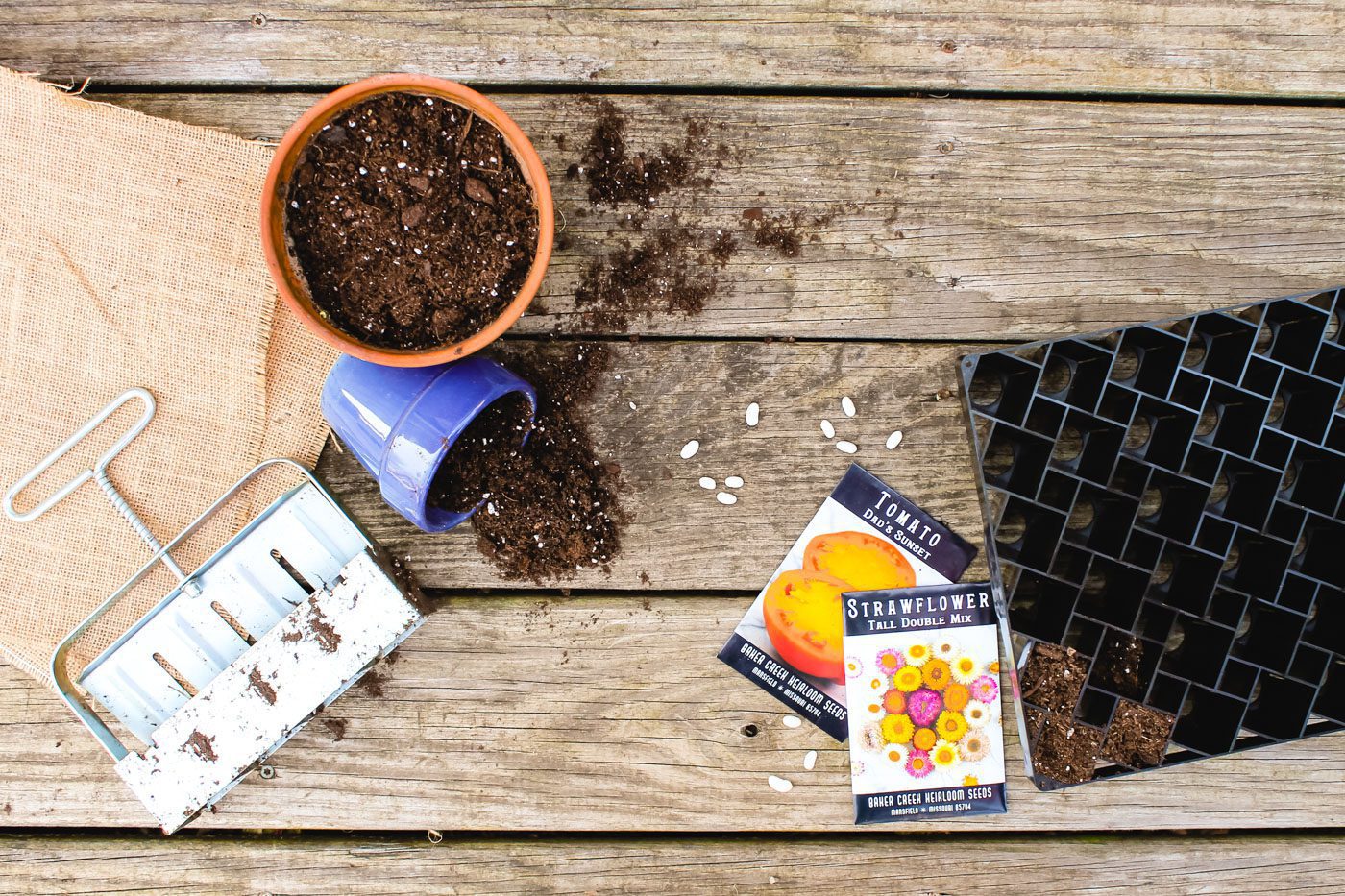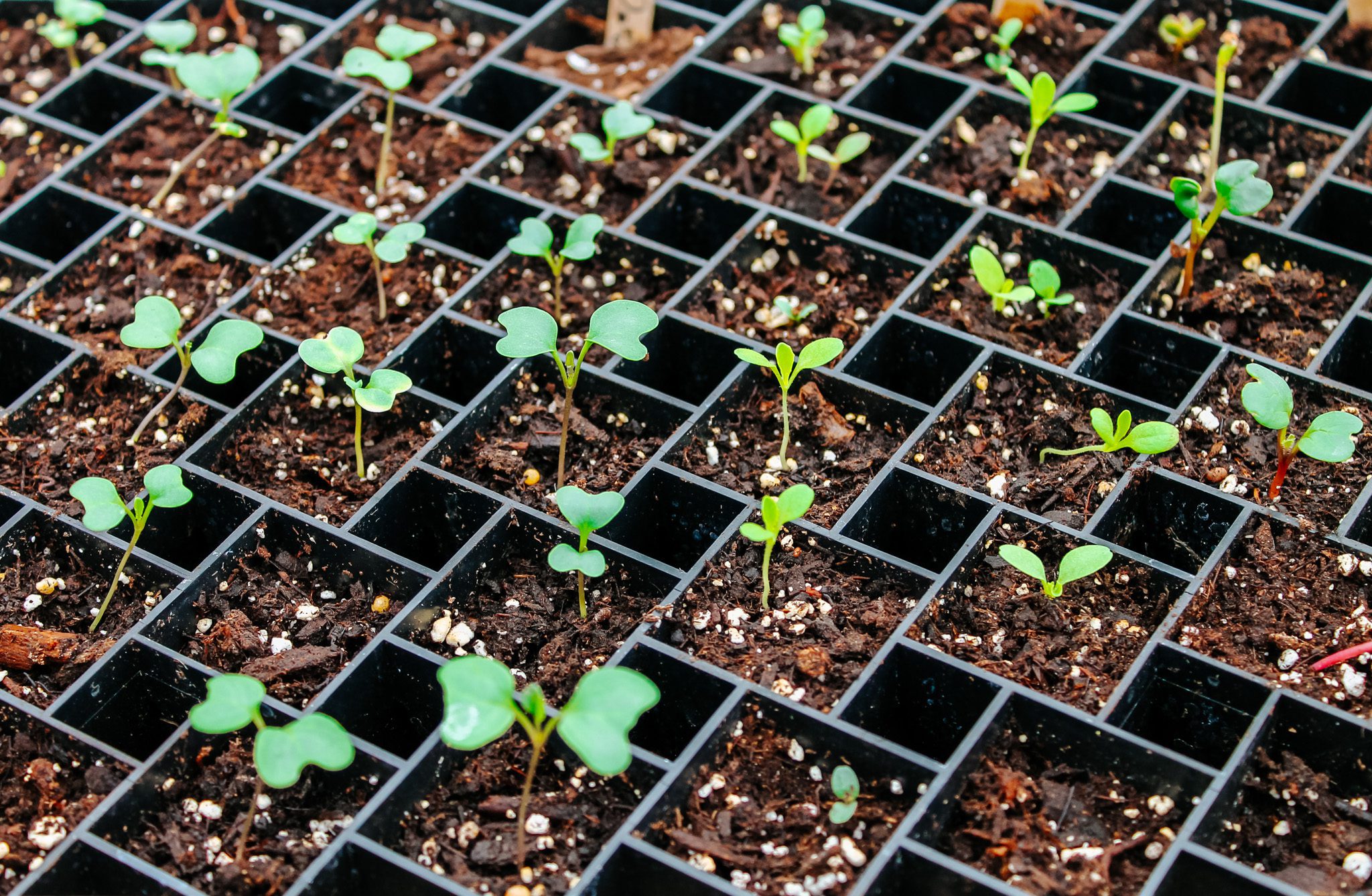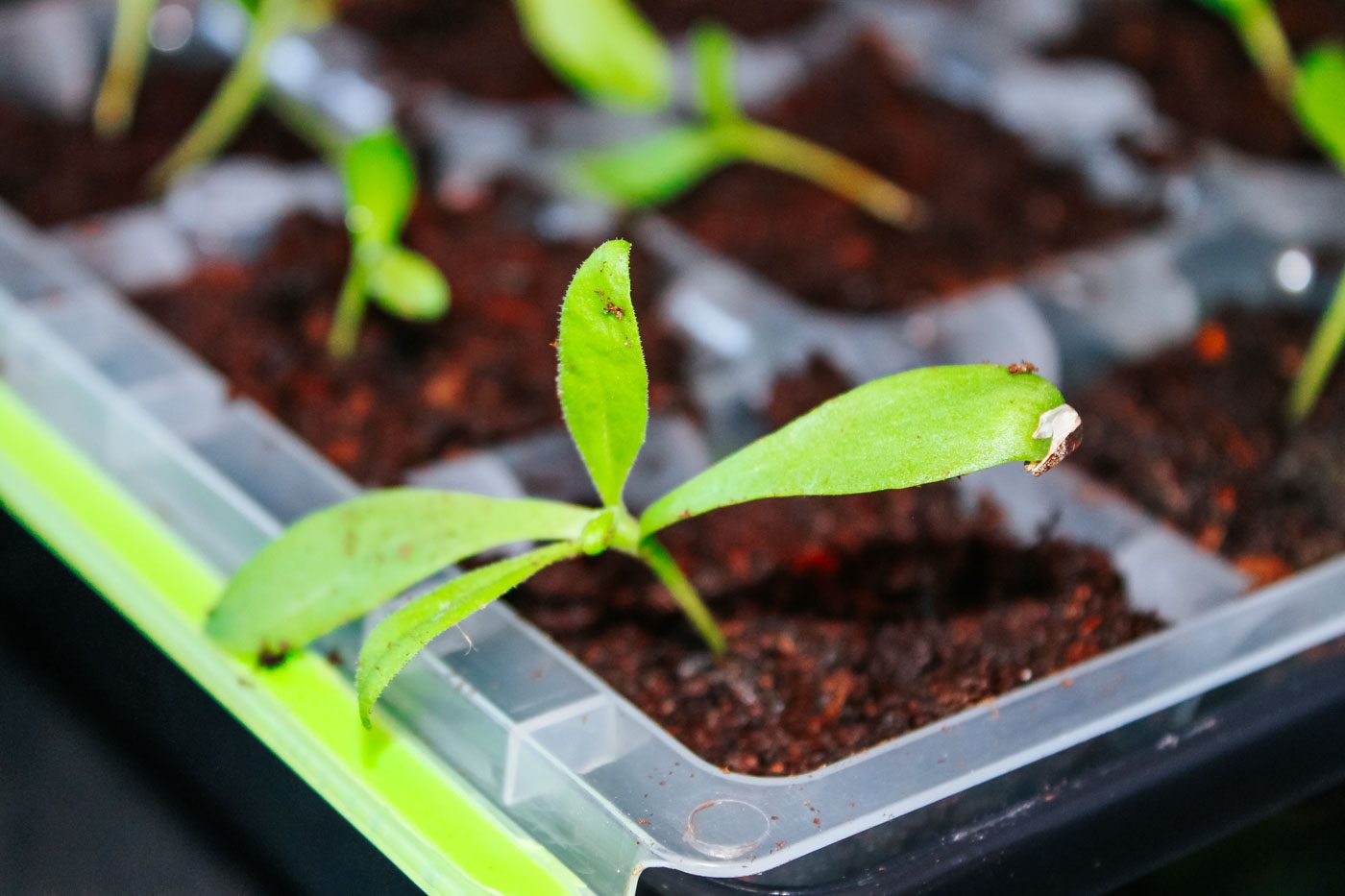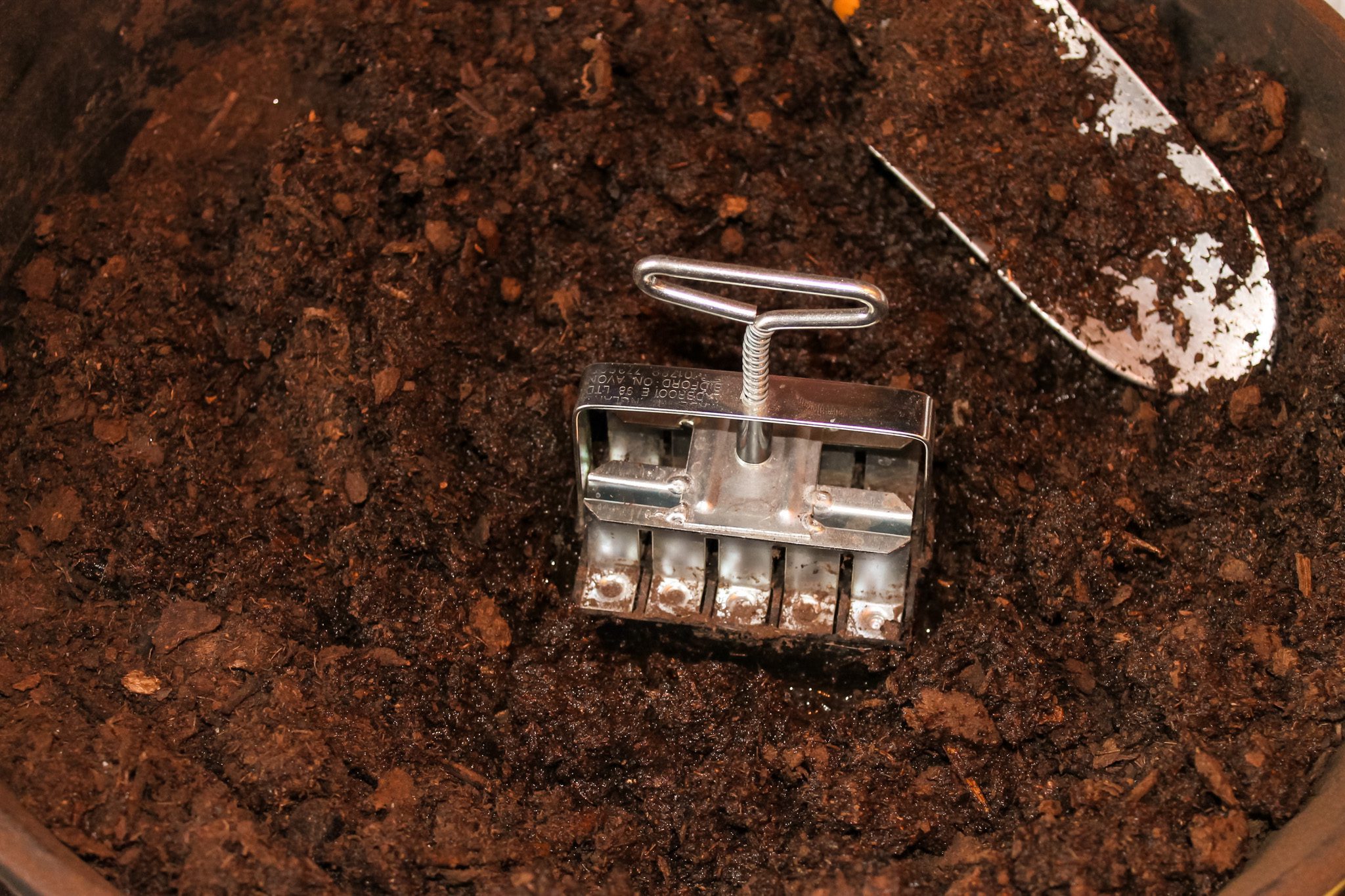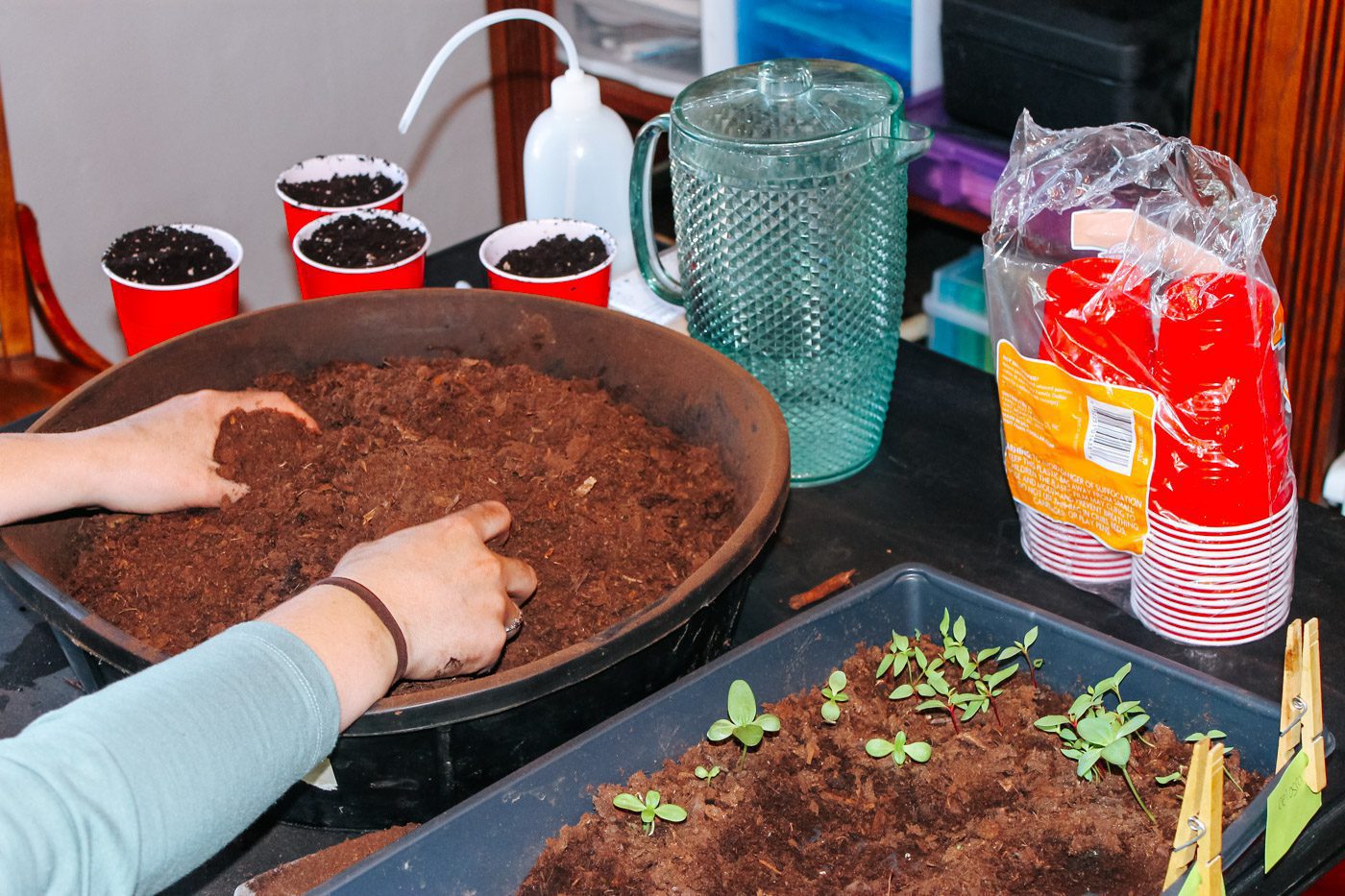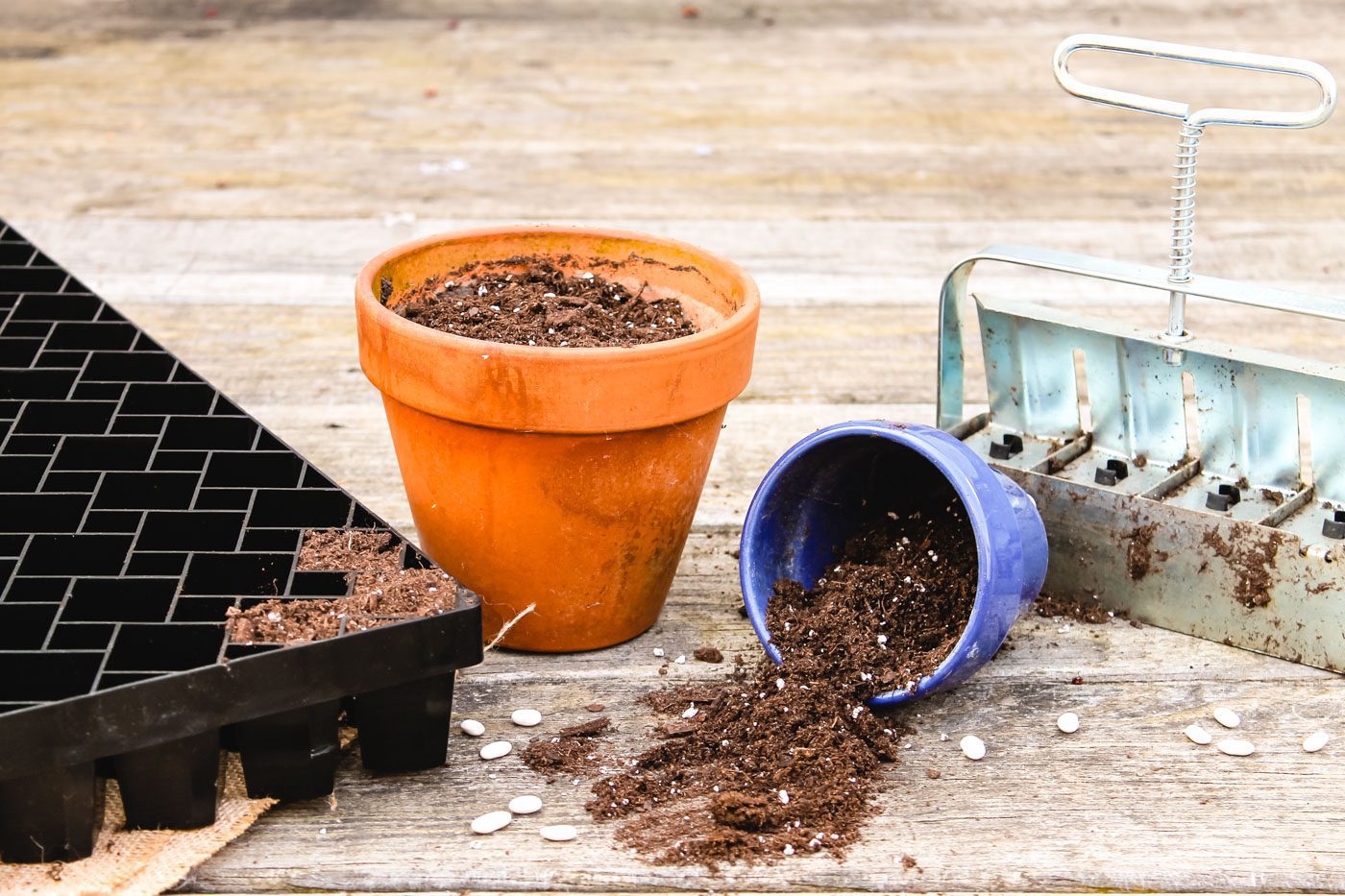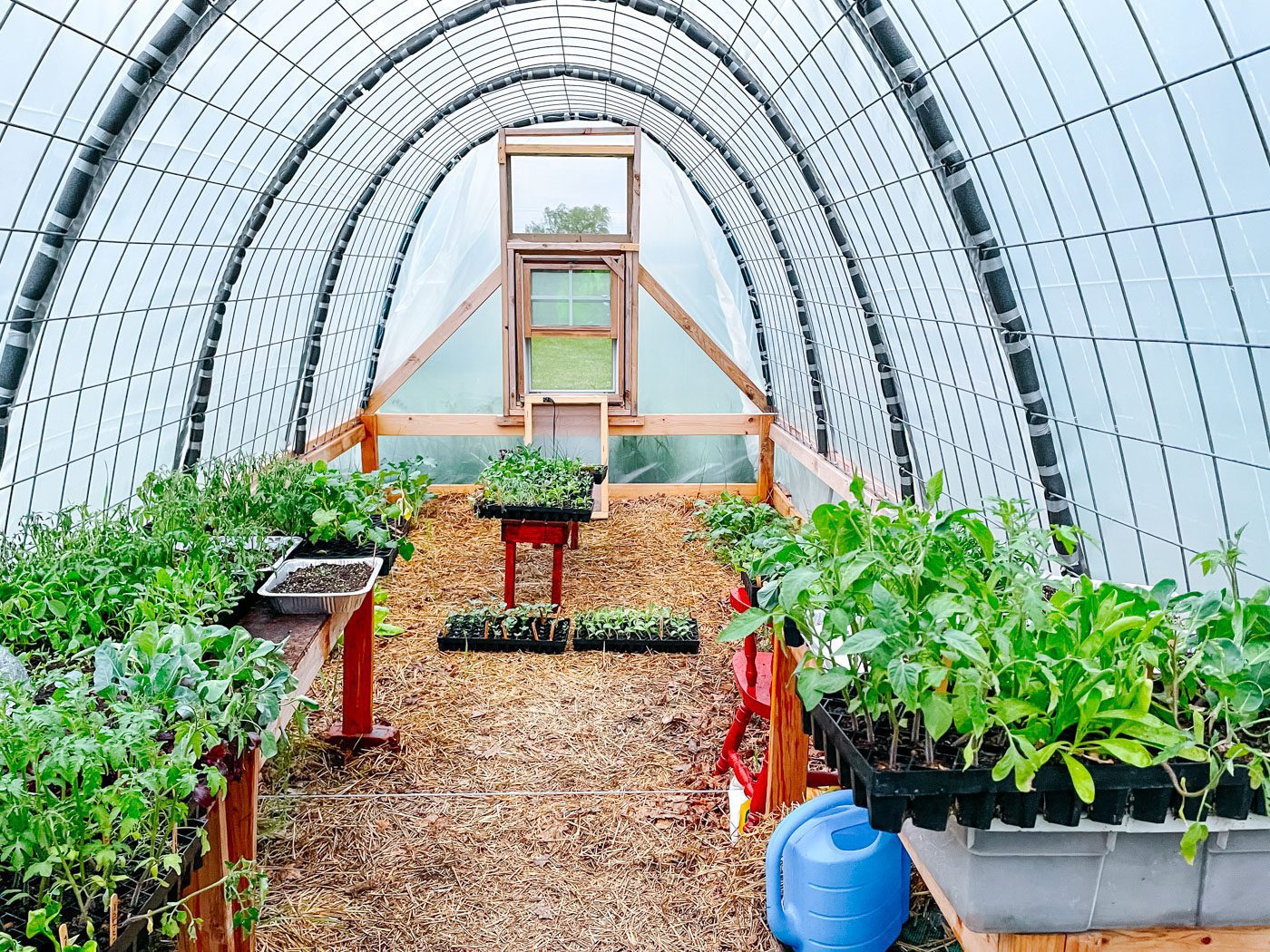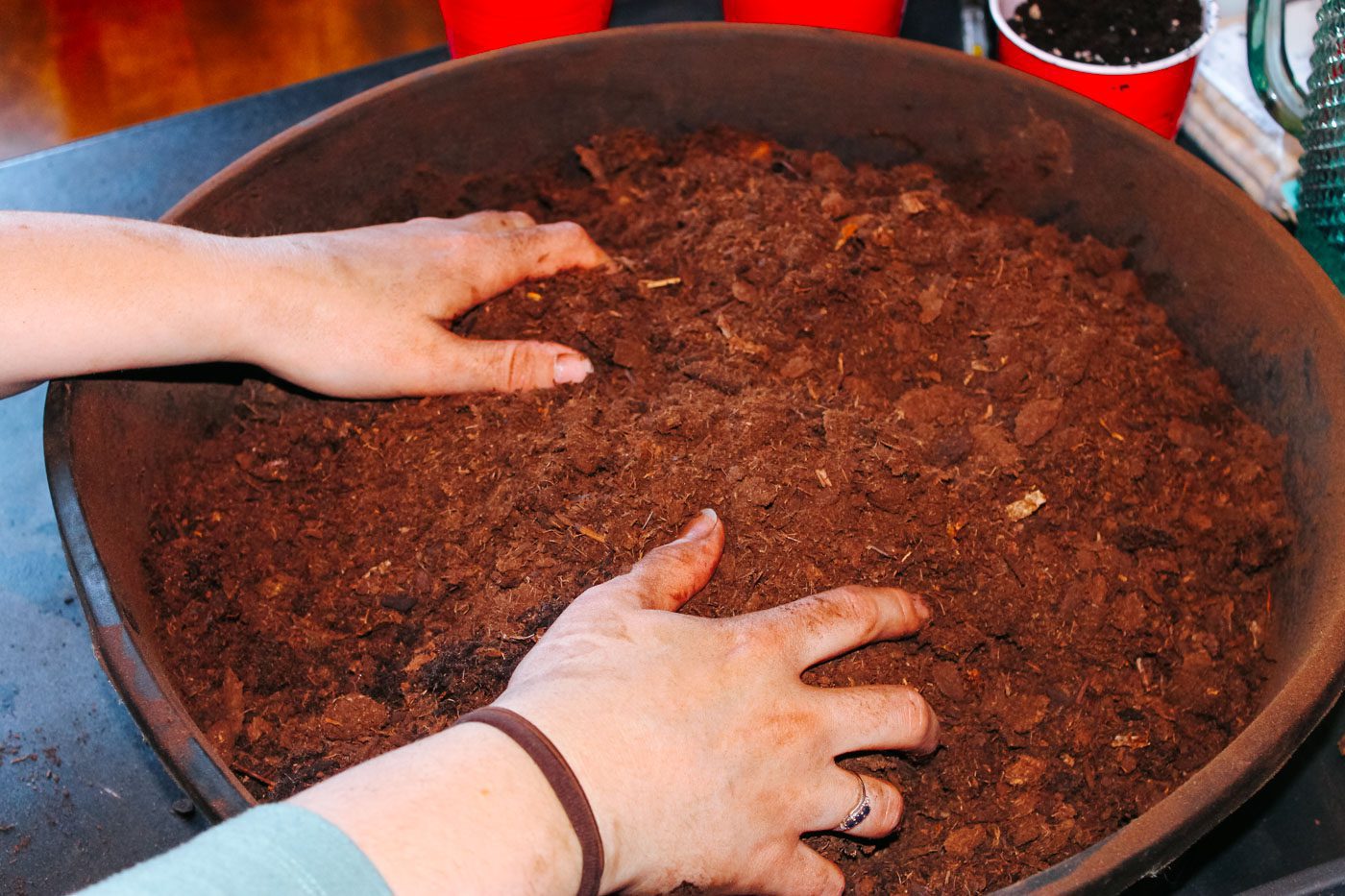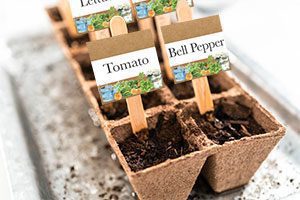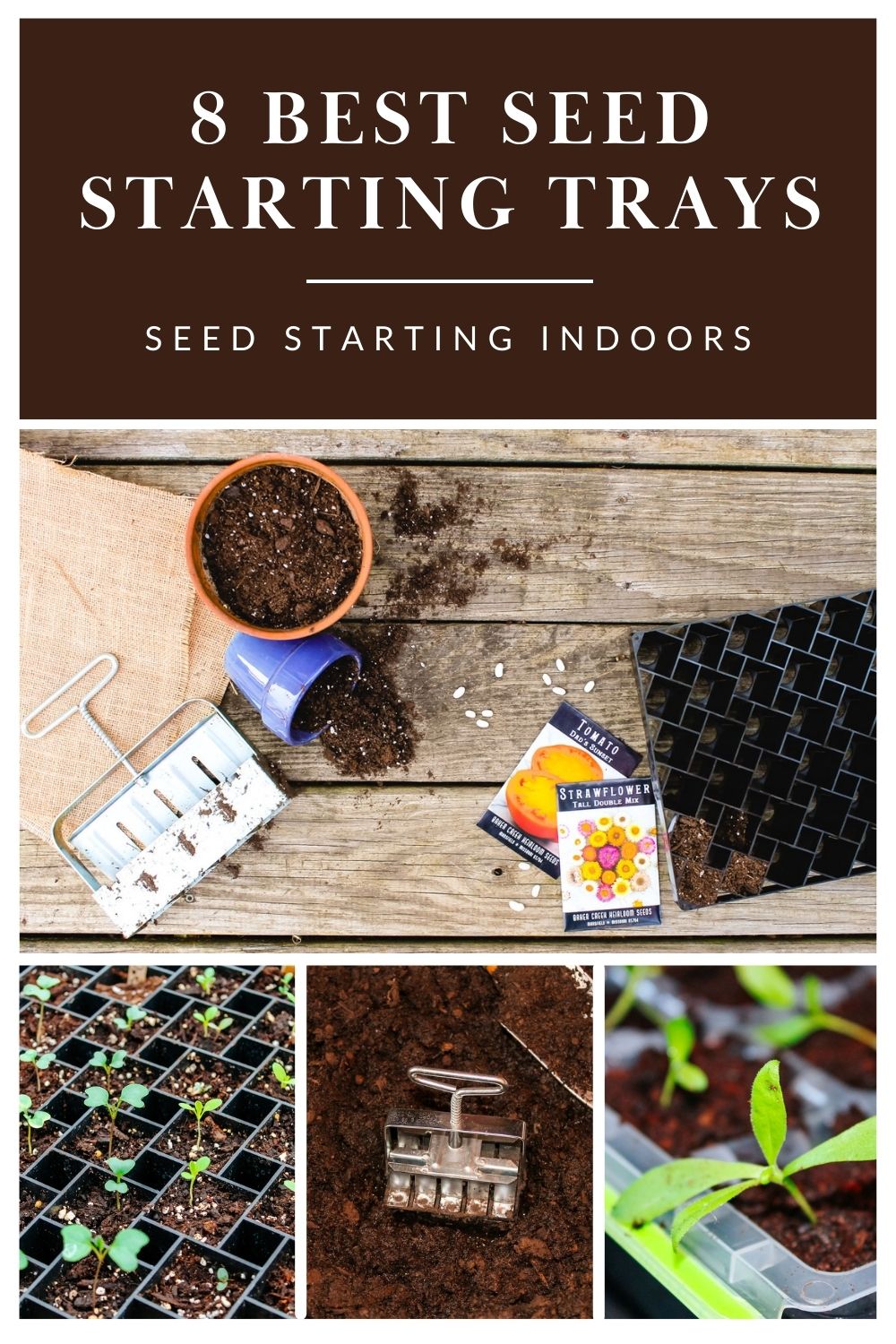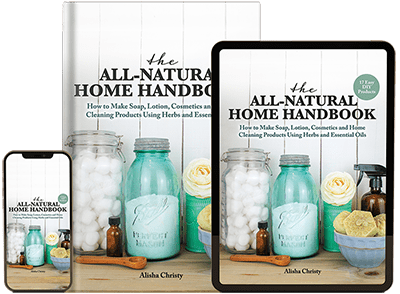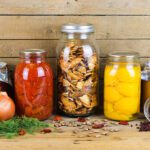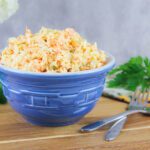Start the gardening season off with strong, healthy seedlings by using quality seed starting supplies. Discover eight of the best seed starting containers and pots, from large high end, reusable trays to budget-friendly, DIY seed starting supplies.
Make sure you scroll to the bottom of this post to grab your FREE printable garden labels.
This post contains affiliate links, which means I make a small commission at no extra cost to you. In any case, I only link to products we actually use on our homestead and that I believe can truly benefit to you. See my full disclosure here.
The Best Seed Starting Trays on the Market
What is the best container to start seeds indoors? That is a common question among gardeners and homesteaders. Can I just use a plastic cup? Do official seed starting kits have a better germination rate? There are many unknowns when you first begin to plan a garden. And a lot of conflicting information available online and in books can occasionally make the task of starting seeds indoors a bit overwhelming.
When my husband and I began gardening several years back, we were fortunate to have a “head start” thanks to my mom and dad. You see my parents had been gardening since I was a child. Having lived in multiple states and two different countries, they experienced poor soil, cold climates, wet and dry seasons, various gardening methods, small backyard gardens as well as a large garden on the farm. Their knowledge and expertise helped us navigate the gardening world quickly.
Soil blocking was the first method we used to sow seeds indoors. We used the England-made Ladbrooke soil blocker and a stack of styrofoam food trays. The germination and transplant rate were quite high. Given the success we had, we continued to use the soil blocking system for many years. As our garden expanded we began diving into other types of seed starting trays and containers. Some worked out great while others gave us less than desirable results. Currently our top two favorite seed starting containers are still the soil block method as well as the large, heavy duty Winstrip tray. Even though we do our primary seed starting in those two containers, we often are found rifling through the garage to find old pots and plastic cups when in need of additional vessels for transplanting sizable plants like luffa and tomatoes.
My hope for you is that this article will give you the needed information to select the best seed starting container for your specific needs.
Top 8 Seed Starting Containers
There are a variety of ways to sow seeds indoors. Below is a compilation of eight of our favorite seed starting containers that have proved to be successful throughout several years of gardening. On the list you will find everything from professional germination trays and the best reusable containers to common vessels for the beginner gardeners and DIY seed starting supplies.
Winstrip Trays
A Winstrip tray, built by Neversink Tools are a terrific, heavy duty plastic seed starting tray. These trays come in a variety of sizes, from 50 cells to 288 cells and work similar to the idea of a soil block. At the bottom of the tray there are uniquely shaped large holes allowing the roots of the plant to grow strong instead of circling into a tangled mess.
While the initial cost of the trays is a bit of an investment, if you purchase the trays in bulk quantities, you will receive quite a discount. We have had our Winstrip trays for a few seasons now and have been very impressed.
Features
- Multiple tray sizes to choose from
- Provides ample airflow around each cell
- Plants tend to be healthier and do not dry out easily
- Trays stack together for convenient storage
- Made in the USA
- Created with BPA-free recycled plastic
- Bottom watering tray is optional and must be purchased separately
Where to Purchase
Burpee SuperSeed Starting Trays
Influenced by another fellow homesteader, last gardening season I purchased the SuperSeed starting trays from Burpee. The bell peppers, cayenne and jalapeños we grew in the seed trays germinated well. The silicone bottom made it easy to pop the plant out when it was time to transplant into the garden. A transparent black watering tray below the cells helps to collect excess water and prevent root damage. We have been happy with our purchase and have found the seed containers to be easy to clean after the seedlings have been transplanted.
Features
- Available in 3 sizes (8 cell, 16 cell and 36 cell)
- Large 2-inch cells
- Silicone container helps to easily pop out seedling
- Side handles make it simple to carry tray outside when you begin to harden off the seedlings
- Sold with a bottom tray to gather excess water
- Does not come with a top cover or dome to keep seedlings warm while sprouting
Where to Purchase
Soil Blocking
The very first way we started seeds indoors was with a soil blocker. Many of our small seeds were planted into the tiny soil block using the Ladbrooke 3/4-inch soil blocker. When the plants outgrew their square, we transplanted the micro block into a large 4-inch mold. The blocks were placed on a small food tray to keep them together and collect any extra water.
The benefits of soil blocking are endless. We like to use soil blocks because it prevents the plants from being root bound and helps reduce the shock of being transplanted. Because the soil blocks are “pot-less” we have additional space to grow more seeds on our indoor seed starting shelving unit.
Features
- Easy to use
- Budget friendly
- Reusable tool
- Made with high quality zinc-plated steel
- Roots are air-pruned
- Soil blocks help to reduce transplant shock and prevent stunting
- No need to purchase new containers year after year
- Blocks can dry out easily and need to be watered frequently
Where to Purchase
Black Plastic Growing Trays
If you are a beginner gardener or are looking for a seed starting tray that is very inexpensive, a lightweight plastic growing tray may be what you are looking for. These types of trays can have multiple seed cells or you can find them built as a giant flat. They are available at almost all hardware stores and sometimes are sold at grocery stores.
I find the large growing flats useful as a drainage tray but they can also be used as a propagation tray for wheatgrass and micro greens. The downside to these types of trays is that they often only last for a season or two unless used very carefully.
Features
- Budget friendly
- Easy to source
- Great for beginners
- Some trays include tear away perforation for separating plants
- Can be fragile
Where to Purchase
Solo Cups
When you see a solo cup, most people think of a big shindig or party. But they can be used for so much more than just drinking. Red solo cups are excellent for starting seeds and transplanting a seedling into a bigger pot. Last year, I started our okra seeds in small soil blocks. When they had outgrown the block, I transferred them to a solo cup. I pricked a hole in the bottom of the cup for drainage and labeled them according to their plant identification. Surprisingly, even though the cups are lightweight they are quite durable and get be reused several times.
Features
- Economical
- Reusable
- Perfect for small scale growers
- Great for growing larger plants like tomatoes and strawflowers
Where to Purchase
Walmart
Grocery stores
Retail discount stores
Gardening Pots
Small gardening pots are great to start seedlings in. There are a variety of materials and sizes to choose from. Square plastic pots are among the most common because they can easily fit into a garden tray or flat. Other options include biodegradable pots, clay pots and galvanized planters. Whichever you select, be sure the container has a drainage hole on the bottom of the pot.
Features
- Suitable for small backyard gardens
- Excellent for transplants
- An array of convenient sizes to choose from
Where to Purchase
Hardware stores
Walmart
Meijers
Styrofoam Coffee Cups
If you don’t have any plastic cups on hand, styrofoam coffee cups work well for starting seeds indoors. Simply fill the cup 3/4 full with quality potting soil or a seed starting mix. Poke a hole into the center of the dirt, place your seed and cover with a light layer of soil. Plant only one seed per cup to avoid overcrowding.
Features
- Inexpensive
- Convenient to use
- Disposable
- Large cup reduces the need to transplant or “pot-up”
Where to Purchase
- Walmart
- Grocery stores
- Retail discount stores
Aluminum Foil Pan
An aluminum pan that you would normally cook a lasagna in is a great DIY seed starter tray. We like to use them to plant a large amount of seeds at once. The foil pan is filled with potting soil then we sprinkle the seeds among the dirt and lightly cover with another layer of soil. The seeds are spritzed with water and placed in a warm spot to germinate. After the seeds have sprouted we transfer them to something like the Winstrip seed starting tray so that each plant has its own cell and the roots do not interweave and become a tangled.
Features
- Budget friendly
- Large planting space
- Foil pans are sold in nearly every grocery or superstore
- Refracted light from the foil helps keep the soil warm
- Reusable if handled gently
Where to Purchase
- Grocery stores
- Discount store such as Dollar General
- Superstores
DIY Seed Starting Container Ideas
If you’re not ready to make the plunge into seed starting supplies there are many common household items that can be easily turned into seed starting trays. Here are a few homemade seed starter ideas:
- Egg cartons
- Yogurt cups
- Milk jugs
- Toilet paper tubes
- Small cardboard box
- Ice cube trays
- Eggshells
FAQ
Which Seeds Should I Start Indoors?
There are many plants, such as tomatoes and bell peppers that will have a far superior growing capability if started indoors. The best way to determine if you should start a seed indoors is to look on the back of a seed packet. There you will find information about how long it takes the seed to sprout, the ideal temperature the plant likes to grow in and when to expect to harvest the plant. Below are just a few of many seeds that should be started indoors:
- Jalapeños
- Kale
- Okra
- Chamomile
- Cabbage
- Cilantro
- Tomatoes
- Zinnia
- Calendula
- Dahlias
When Do I Start Seeds Indoors?
The timeframe of when to start your seeds indoors depends on where you live. It is best to begin your seeds about 45-60 days before your last frost date. Before you sow your seeds, you will need to determine your zone number. Knowing what zone you are in will not only help you to be aware of when to begin planting your seeds indoors but it will also help you determine what plant thrives in your area and what does not.
Do I Need to Sterilize Seed Starting Trays?
Yes and no. To be honest there have been years that I did not disinfect my seedling trays and my plants grew beautifully. Other years I have given my seed starting trays a quick spray and rinse and had no problems with disease. The reason you would want to disinfect your seed containers is if you had any problems with disease or fungi issues in the previous years.
To sterilize your seed trays rinse out any remaining soil with water. Spray the containers with either bleach, vinegar or hydrogen peroxide. Let everything sit and dry completely before using the trays. I have also found sitting the trays outside in the sunshine can not only help disinfect the trays but also encourage them to dry quickly.
Should You Cover the Seed Tray or Pots?
A light covering can be beneficial when starting seeds indoors, however it isn’t required. By adding a cover or layer of plastic wrap over the seed trays, you create a greenhouse-like effect. This helps to keep the soil moist and warm until the seeds sprout. Once sprouted, you can remove the cover.
How Long Do You Leave Seedlings in a Seed Tray?
Plants such as peppers, lettuce and lemon balm can stay in a small seed starting tray for a couple of weeks. As the plant grows bigger you will need to transplant them into a larger container. By “potting-up” you provide the seedling more nutrients and room for their root system to expand.
More Gardening Tutorials and How-Tos
Vertical Gardening for Small Spaces

